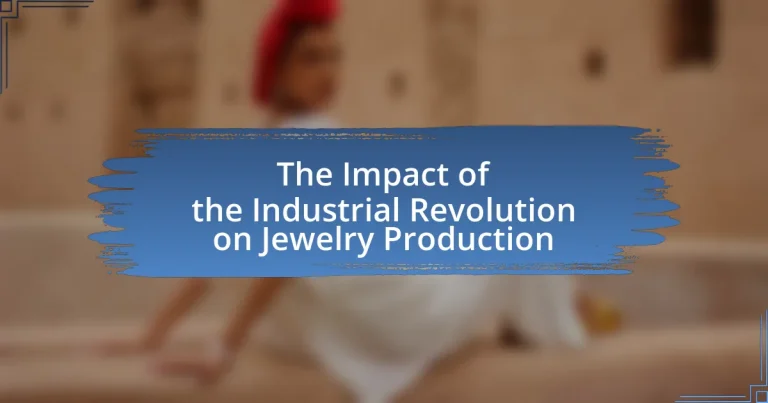The article examines the profound impact of the Industrial Revolution on jewelry production, highlighting the transition from traditional handcrafting to mechanized mass production. Key advancements, such as steam-powered machinery and new materials, enabled jewelers to produce intricate designs more efficiently and at lower costs, making jewelry accessible to a broader audience. The article also discusses the social implications of these changes, including shifts in consumer preferences, the democratization of jewelry ownership, and the emergence of new markets. Additionally, it explores the lasting effects of these historical developments on contemporary jewelry production methods and best practices.

What is the Impact of the Industrial Revolution on Jewelry Production?
The Industrial Revolution significantly transformed jewelry production by introducing mechanization and mass production techniques. This shift allowed for the creation of jewelry on a larger scale, reducing costs and making it more accessible to the general public. For instance, the introduction of steam-powered machinery in the 19th century enabled jewelers to produce intricate designs more efficiently than traditional handcrafting methods. Additionally, advancements in metallurgy and the availability of new materials, such as gold plating and synthetic gemstones, expanded design possibilities and affordability. By the late 1800s, jewelry became a popular consumer good, reflecting broader societal changes in wealth distribution and fashion trends.
How did the Industrial Revolution change the methods of jewelry production?
The Industrial Revolution transformed jewelry production by introducing mechanization and mass production techniques. This shift allowed for the creation of jewelry on a larger scale, significantly reducing production time and costs. For instance, the use of steam-powered machinery enabled jewelers to produce intricate designs more efficiently than traditional handcrafting methods. Additionally, the introduction of new materials, such as alloys and synthetic stones, expanded design possibilities and accessibility. By the late 19th century, factories began to dominate the jewelry industry, leading to standardized products that catered to a broader market, thus democratizing access to jewelry that was once exclusive to the wealthy.
What traditional techniques were replaced during the Industrial Revolution?
During the Industrial Revolution, traditional techniques such as handcrafting and artisanal methods of jewelry production were largely replaced by mechanized processes. The introduction of machinery allowed for mass production, which significantly increased efficiency and reduced costs. For instance, the use of steam-powered tools and later electric machinery enabled jewelers to produce items at a scale and speed that handcrafting could not match. This shift not only transformed the production methods but also changed the nature of jewelry design, leading to more standardized and less personalized pieces.
How did mechanization influence jewelry design and manufacturing?
Mechanization significantly transformed jewelry design and manufacturing by introducing precision and efficiency in production processes. The advent of machines such as the rolling mill and the stamping press allowed for the mass production of intricate designs, which were previously crafted by hand, thus reducing labor costs and time. For instance, the introduction of the steam engine in the 18th century enabled jewelers to operate machinery that could produce components at a scale and speed unattainable by manual methods. This shift not only increased the availability of jewelry but also democratized access to it, allowing a broader segment of the population to purchase and wear jewelry. The mechanization of processes like casting and polishing further enhanced the quality and consistency of finished products, leading to a new era of design possibilities that combined artistic creativity with industrial efficiency.
What were the social implications of changes in jewelry production?
The social implications of changes in jewelry production during the Industrial Revolution included increased accessibility to jewelry, shifts in social status, and the rise of consumer culture. The introduction of mechanized production methods allowed for mass production, which significantly lowered costs and made jewelry available to a broader segment of society, rather than just the wealthy elite. This democratization of jewelry led to changes in social dynamics, as individuals from various social classes could now participate in the adornment practices that were previously exclusive. Additionally, the rise of consumer culture fostered a new identity tied to material possessions, influencing social interactions and personal expression. Historical evidence shows that by the late 19th century, jewelry became a staple of middle-class life, reflecting changing values around wealth and status.
How did the Industrial Revolution affect the workforce in jewelry production?
The Industrial Revolution significantly transformed the workforce in jewelry production by introducing mechanization and mass production techniques. This shift led to a decrease in the number of skilled artisans, as machines could produce jewelry more quickly and at a lower cost. For instance, the introduction of steam-powered machinery allowed for the rapid creation of intricate designs that previously required extensive manual labor. Consequently, many traditional jewelers faced unemployment or were forced to adapt to new roles within factories, which often emphasized repetitive tasks over craftsmanship. This transition marked a pivotal change in the jewelry industry, moving from bespoke, handcrafted items to standardized products aimed at a broader market.
What role did jewelry play in the changing social dynamics of the time?
Jewelry served as a significant indicator of social status and wealth during the Industrial Revolution, reflecting the changing social dynamics of the time. As mass production techniques emerged, jewelry became more accessible to the middle class, which altered traditional class distinctions. The introduction of new materials, such as gold plating and synthetic gemstones, allowed a broader segment of society to adorn themselves with items that previously signified elite status. This democratization of jewelry not only transformed personal adornment but also influenced social interactions, as individuals used jewelry to express newfound wealth and identity in a rapidly industrializing society.
What economic effects did the Industrial Revolution have on the jewelry industry?
The Industrial Revolution significantly transformed the jewelry industry by introducing mass production techniques, which lowered costs and increased accessibility. This shift allowed for the creation of affordable jewelry, making it available to a broader segment of the population, rather than just the wealthy elite. The introduction of machinery and new materials, such as gold plating and synthetic gemstones, further enhanced production efficiency and variety. By the late 19th century, the jewelry market expanded dramatically, with the establishment of large-scale factories and the rise of retail chains, reflecting a shift from artisanal craftsmanship to industrial manufacturing. This economic transformation resulted in a democratization of jewelry ownership and a diversification of styles and designs available to consumers.
How did mass production impact the pricing of jewelry?
Mass production significantly lowered the pricing of jewelry by enabling manufacturers to produce items at a larger scale and reduced costs. The introduction of assembly line techniques during the Industrial Revolution allowed for faster production times and decreased labor costs, which in turn made jewelry more accessible to a broader audience. For example, the use of machines for cutting and polishing gemstones and metals reduced the need for skilled artisans, leading to lower prices. As a result, jewelry that was once considered a luxury item became more affordable, with prices dropping by as much as 50% in some cases due to these efficiencies.
What new markets emerged for jewelry during the Industrial Revolution?
During the Industrial Revolution, new markets for jewelry emerged primarily due to increased production capabilities and changing consumer demographics. The rise of mass production techniques allowed for the creation of affordable jewelry, making it accessible to the growing middle class. Additionally, the expansion of global trade networks introduced exotic materials and styles, further diversifying the market. The introduction of costume jewelry, which utilized non-precious materials, catered to a broader audience, reflecting the era’s shift towards consumerism and fashion. This period marked a significant transformation in the jewelry industry, as it adapted to meet the demands of a rapidly changing society.
How did the Industrial Revolution influence jewelry styles and trends?
The Industrial Revolution significantly influenced jewelry styles and trends by introducing mass production techniques and new materials. This period, spanning from the late 18th to the early 19th century, allowed for the creation of intricate designs at a lower cost, making jewelry more accessible to the middle class. The introduction of machinery enabled jewelers to produce items like brooches and rings in larger quantities, leading to the popularity of styles such as Victorian and Art Nouveau, characterized by elaborate motifs and the use of semi-precious stones. Additionally, advancements in metallurgy and the availability of materials like gold plating and synthetic gems further diversified jewelry options, reflecting the era’s technological progress and changing social dynamics.
What new materials became popular in jewelry production during this period?
During the Industrial Revolution, new materials such as aluminum, synthetic gemstones, and plastics became popular in jewelry production. Aluminum emerged as a lightweight and affordable alternative to precious metals, allowing for innovative designs and mass production. Synthetic gemstones, created through chemical processes, provided a cost-effective and ethically sourced option that mimicked the appearance of natural stones. Additionally, plastics offered versatility and color options, enabling designers to experiment with forms and styles previously unattainable with traditional materials. These advancements significantly transformed the jewelry industry, making it more accessible and diverse.
How did consumer preferences shift as a result of industrialization?
Consumer preferences shifted significantly as a result of industrialization, leading to increased demand for mass-produced goods, including jewelry. The rise of factories enabled the production of affordable, standardized items, which contrasted with the previously favored handcrafted luxury pieces. This transition was driven by a growing middle class with disposable income, who sought fashionable yet accessible jewelry options. Historical data indicates that by the late 19th century, the introduction of new materials like gold plating and synthetic gemstones further influenced consumer choices, making jewelry more attainable for a broader audience.
What technological advancements were pivotal in jewelry production during the Industrial Revolution?
The technological advancements pivotal in jewelry production during the Industrial Revolution included the introduction of steam-powered machinery, the use of precision tools, and the development of new alloys. Steam-powered machinery allowed for mass production, significantly increasing output and reducing labor costs. Precision tools, such as the lathe and the rolling mill, enabled jewelers to create intricate designs with greater accuracy and consistency. Additionally, the creation of new alloys, like gold-filled and plated metals, made jewelry more affordable and accessible to a broader audience. These advancements collectively transformed the jewelry industry, facilitating the transition from handcrafted to industrialized production methods.
How did innovations like the steam engine affect jewelry manufacturing?
Innovations like the steam engine significantly transformed jewelry manufacturing by enabling mass production and increasing efficiency. The steam engine allowed for the mechanization of processes that were previously labor-intensive, such as metalworking and stone cutting. This mechanization led to a reduction in production costs and time, allowing jewelers to produce items on a larger scale. For instance, the introduction of steam-powered machinery in the 19th century facilitated the creation of intricate designs that were not feasible with handcrafting alone. Consequently, the jewelry industry experienced a shift from bespoke, handcrafted pieces to more affordable, mass-produced items, making jewelry accessible to a broader audience.
What role did new tools and machinery play in jewelry design?
New tools and machinery significantly transformed jewelry design by enhancing precision, efficiency, and creativity. The introduction of technologies such as the steam engine and electric tools allowed for mass production, enabling jewelers to create intricate designs at a faster rate. For instance, the use of the rolling mill and laser cutting machines facilitated the production of uniform shapes and detailed patterns that were previously labor-intensive and time-consuming. This technological advancement not only reduced costs but also expanded the variety of designs available, making jewelry more accessible to a broader audience. Historical evidence shows that during the Industrial Revolution, jewelry production increased dramatically, with factories producing thousands of pieces compared to the artisanal methods of the past.
What are the lasting effects of the Industrial Revolution on modern jewelry production?
The lasting effects of the Industrial Revolution on modern jewelry production include the introduction of mass production techniques, which significantly increased the availability and affordability of jewelry. The advent of machinery allowed for the rapid creation of intricate designs and standardized pieces, reducing labor costs and time. For instance, the use of stamping and casting techniques enabled jewelers to produce items in large quantities, making jewelry accessible to a broader audience. Additionally, the Industrial Revolution fostered innovations in materials, such as the development of synthetic gemstones and improved metal alloys, which expanded design possibilities and enhanced durability. These advancements have shaped contemporary jewelry production, emphasizing efficiency, variety, and affordability.
How do contemporary jewelry production methods reflect historical changes?
Contemporary jewelry production methods reflect historical changes by integrating advanced technologies and mass production techniques that emerged during the Industrial Revolution. The Industrial Revolution introduced mechanization, which allowed for the efficient production of jewelry, shifting from handcrafted methods to machine-assisted processes. For instance, the use of computer-aided design (CAD) and 3D printing in modern jewelry production exemplifies this evolution, enabling intricate designs that were previously labor-intensive and time-consuming. Additionally, the rise of global supply chains and access to diverse materials has transformed the sourcing and manufacturing processes, showcasing a departure from localized craftsmanship to a more industrialized approach. This shift highlights the ongoing influence of historical advancements in technology and production methods on contemporary practices in the jewelry industry.
What lessons can modern jewelers learn from the Industrial Revolution?
Modern jewelers can learn the importance of efficiency and mass production from the Industrial Revolution. During this period, advancements in machinery and manufacturing processes allowed for the rapid production of goods, significantly reducing costs and increasing accessibility. For instance, the introduction of steam-powered tools and assembly line techniques enabled jewelers to produce intricate designs at a scale previously unattainable. This historical shift illustrates that embracing technology and optimizing production methods can enhance profitability and meet consumer demand effectively.
What best practices can be adopted in jewelry production today based on historical insights?
Best practices in jewelry production today include the adoption of mechanized techniques and the emphasis on quality control, both of which were significantly influenced by the Industrial Revolution. Historical insights reveal that the introduction of machinery allowed for mass production, which increased efficiency and reduced costs. For instance, the use of steam-powered tools in the 19th century enabled jewelers to produce intricate designs at a faster rate, a practice that can be mirrored today by integrating modern technology such as CAD (Computer-Aided Design) and CNC (Computer Numerical Control) machines. Additionally, the focus on quality control emerged during this period, as manufacturers began to implement standardized measurements and testing methods to ensure product consistency. This historical precedent supports the current practice of rigorous quality assurance processes, which enhance customer satisfaction and brand reputation in the jewelry industry.


